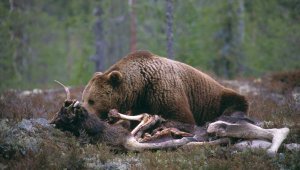The purpose of the Habitats Directive is to promote and support biodiversity and sustainable development. The Directive aims to secure the preservation of rare and endangered species on the territories of the European Community. These efforts focus on species listed in the annexes of the Directive.
The annexes of the Directive also list the four large carnivores living in Finland:
- The wolverine is listed in Annex II as one of the species that require the designation of Special Areas of Conservation. This refers to areas belonging to the Natura 2000 network.
- Annex IV lists species that require strict protection, and this category includes the brown bear and the lynx in all of Finland and the wolf outside of the reindeer herding area.
- When wolves are in the reindeer herding area, they are considered an Annex V species.
The conservation of large carnivores is key
Finland has a strict protection system in place for species listed in Annex IV of the Habitats Directive. The deliberate killing or capturing of bears, lynxes and wolves in the wild is forbidden (Article 12). The Directive also forbids other deliberate disturbance of these species. The Habitats Directive does not regulate wolverine hunting. Wolf hunting is not regulated as strictly when the wolf is in the reindeer herding area.
Exceptions may be made to the strict protection of bears, wolves and lynxes under certain circumstances (Article 16). Exceptions can be made, for example, to prevent serious damages to crops, livestock, forests, fisheries, water systems and other property. Exceptions can also be made in the interests of public health and safety or for some other imperative reasons concerning public interests.
In addition to these specified exceptions, the Habitats Directive allows hunting on a more general level.
Hunting for the purposes of population management
The European Commission has approved a guidance document for the interpretation of Article 16 of the Habitats Directive. The guidance document is largely based on key decisions made by the Court of Justice of the European Union (CJEU), the work of the Article 12 working group and, in certain special cases, on the views of the European Commission's Legal Service. The document is intended to guarantee a common understanding among the national and regional authorities, conservation organisations and other operators responsible for or involved in the execution of the Habitats Directive. It intends to provide practical and flexible ways to apply the regulations of the Directive within existing legal frameworks. The CJEU has also used this guidance document to support its interpretations of the Habitats Directive. The document creates a clear and consistent basis for applying Article 16.
The guidance document specifically recommends the use of the exception intended in Article 16(1)(e), i.e., hunting for the purposes of population management, when the member state has a management plan in place for the species in question. The Commission uses the Latvian lynx management plan as an example. The Commission states that limited and strictly controlled hunting can be seen to have a positive effect on both the animal population and popular opinion. For this reason, the strictly regulated hunting of large carnivores is completely in line with Article 16(1)(e).
Other satisfactory alternatives and favourable conservation status
Before an exception can be made to hunt a large carnivore for any of the reasons listed above, the Directive requires that all other possible satisfactory alternatives are exhausted. Using an electric fence to fend off a problematic animal is an example of such an alternative that needs to be considered. It is also crucial to always ensure that hunting the animal does not negatively affect the goal of achieving a favourable conservation status for the species.
